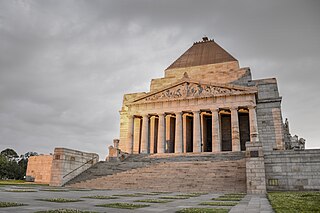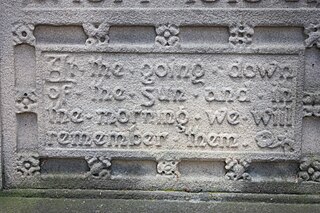
Anzac Day is a national day of remembrance in Australia and New Zealand that broadly commemorates all Australians and New Zealanders "who served and died in all wars, conflicts, and peacekeeping operations" and "the contribution and suffering of all those who have served". Observed on 25 April each year, Anzac Day was originally devised to honour the members of the Australian and New Zealand Army Corps (ANZAC) who served in the Gallipoli campaign, their first engagement in the First World War (1914–1918).

Remembrance Day is a memorial day observed in Commonwealth member states since the end of the First World War to honour armed forces members who have died in the line of duty. The day is also marked by war remembrances in several other non-Commonwealth countries. In most countries, Remembrance Day is observed on 11 November to recall the end of First World War hostilities. Hostilities ended "at the 11th hour of the 11th day of the 11th month" of 1918, in accordance with the armistice signed by representatives of Germany and the Entente between 5:12 and 5:20 that morning. The First World War formally ended with the signing of the Treaty of Versailles on 28 June 1919.
The Australian honours and awards system refers to all orders, decorations, and medals, as instituted by letters patent from the Monarch of Australia and countersigned by the Australian prime minister at the time, that have been progressively introduced since 14 February 1975. The Australian honours and awards system excludes all state and local government, and private, issued awards and medals.

The Australian War Memorial (AWM) is a national war memorial and museum dedicated to all Australians who died during war. The AWM is located in Campbell, a suburb of the Australian capital of Canberra. The grounds include five buildings and a sculpture garden. Most of the museum galleries and commemorative areas are contained in the Memorial Building.

The Anzac Memorial is a heritage-listed war memorial, museum and monument located in Hyde Park South near Liverpool Street in the CBD of Sydney, Australia. The Art Deco monument was designed by C. Bruce Dellit, with the exterior adorned with monumental figural reliefs and sculptures by Rayner Hoff, and built from 1932 to 1934 by Kell & Rigby. This state-owned property was added to the New South Wales State Heritage Register on 23 April 2010.

The Shrine of Remembrance is a war memorial in Melbourne, Victoria, Australia, located in Kings Domain on St Kilda Road. It was built to honour the men and women of Victoria who served in World War I, but now functions as a memorial to all Australians who have served in any war. It is a site of annual observances for Anzac Day and Remembrance Day, and is one of the largest war memorials in Australia.
Sergeant Edward David "Ted" Smout OAM was an Australian soldier in the First World War. He was Australia's 6th last surviving World War I veteran.
Alexander William Campbell was the final surviving Australian participant of the Gallipoli campaign during the First World War. Campbell joined the Australian Army at the age of 16 in 1915, and served as a stores carrier for two months during the fighting at Gallipoli. He was invalided home and discharged in 1916. He later worked in large number of roles, was twice married and had nine children. He is the great-grandfather of actress, singer and model Ruby Rose.
Peter Casserly was, at age 107, the last surviving member of the 1st AIF serving in France in the First World War. At the time of his death, he was believed to be the oldest living Australian man, and his marriage to Monica Delgado was also believed to be Australia's longest.

ANZAC Square is a heritage-listed town square and war memorial located between Ann Street and Adelaide Street, in Brisbane, Queensland, Australia. It is a state memorial to the men and women who participated in overseas armed service and is named in honour of the Australian and New Zealand Army Corps. ANZAC Square is adjacent to ANZAC Square Arcade.
John Henry Lockett was the oldest man ever in Australia when he died aged 111 years, 123 days. As one of the last surviving veterans of World War I, he was acclaimed as a national hero during the last decade of his life.

The Shrine of Remembrance is located in ANZAC Square, between Ann Street and Adelaide Street, in Brisbane, Queensland, Australia. With its 'Eternal Flame', the Shrine is a war memorial dedicated to the Australian and New Zealand Army Corps (Anzacs).

The Australian two-dollar coin is the highest-denomination coin of the Australian dollar. It was first issued on 20 June 1988, having been in planning since the mid-1970s. It replaced the Australian two-dollar note due to having a longer circulatory life. The only "mint set only" year was 1991.

"For the Fallen" is a poem written by Laurence Binyon. It was first published in The Times in September 1914.
The Governor-General of Australia has, at irregular intervals, notified for general information notifies the positioning of wearing of Australian orders, decorations and medals in the Commonwealth of Australia Gazette. The Order of Wearing Australian Honours and Awards was last published in 2007.
Charlie Mance was a highly decorated Australian soldier who fought in many battles during World War I.
Walter Parker was an Australian soldier and the third last surviving veteran of the Australian and New Zealand Army Corps (ANZAC) who served in World War I.

Roy Longmore was an Australian soldier and centenarian, who after Alec Campbell, was noted as the second last living Australian and New Zealand Army Corps (ANZAC) veteran who saw service in World War I.

4th/3rd Battalion, Royal New South Wales Regiment is a Reserve light infantry battalion of the Australian Army. 4/3 RNSWR has been deployed on active service on many peacekeeping operations and exercises within Australia and around the world. The Battalion is currently based at Sutherland, New South Wales where it forms part of the 5th Brigade.
Eric Kingsley Abraham was an Australian World War I veteran who is notable for having been the last surviving recruit of Australia's famous snowball march, the March of the Dungarees.










